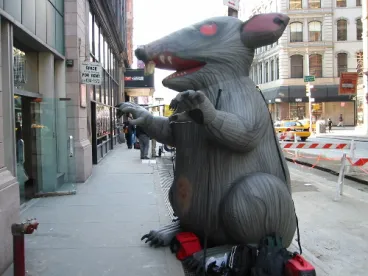A union’s use of Scabby the Rat (an inflatable rat “approximately 12 feet in height with red eyes, fangs, and claws”) and inflammatory banners targeting a neutral employer, without more, does not violate the National Labor Relations Act (NLRA), the National Labor Relations Board (NLRB) has ruled. Lippert Components Inc., 371 NLRB No. 8 (July 21, 2021).
For more than three decades, unions have displayed Scabby (or other inflatable animals, including gorillas) on public property to protest companies for reasons including doing business with employers the union finds objectionable. Whether Scabby is akin to lawful handbilling or unlawful picketing directed at a neutral employer is the subject of much debate. (See our article, Why Is ‘Scabby the Rat’ a Legal Dilemma?, for legal background on Scabby.)
Republican-appointed NLRB General Counsels have tried to eradicate Scabby when deployed against neutral employers. In the early 2000s, General Counsel Arthur Rosenfeld (a Republican appointee) issued complaints over the use of Scabby, arguing it was inherently a symbol of a labor dispute and its display constituted signal picketing or otherwise coercive conduct in violation of NLRA Section 8(b)(4). The Republican-appointed majority NLRB at that time avoided ruling on the issue, finding it unnecessary to address Scabby due to the other union misconduct. See, e.g., Ranches at Mt. Sinai, 346 NLRB 1251 (2006); Brandon Regional Med. Ctr., 346 NLRB 199, 200 n.3 (2006). Scabby continued to make appearances at union demonstrations.
In Lippert Components, a union displayed Scabby and two large banners near the public entrance of a large trade show in Indiana for a four-day period in 2018. One banner criticized a manufacturer for alleged safety violations. The other criticized a neutral supply company for doing business with that manufacturer. The supply company filed an unfair labor practice charge alleging, among other things, the rat-and-banner display violated NLRA Section 8(b)(4)(ii)(B).
Under Section 8(b)(4)(ii)(B), it is unlawful for a union “to threaten, coerce, or restrain” a neutral employer where an objective is for the neutral employer to cease doing business with another entity. The NLRB’s prior General Counsel Peter Robb (a Republican appointee) issued a complaint against the union, alleging the rat-and-banner display was unlawfully coercive and constituted “signal picketing.”
An administrative law judge (ALJ) found the rat-and-banner display did not constitute picketing or otherwise coercive nonpicketing conduct in violation of Section 8(b)(4)(ii)(B). The ALJ relied on Eliason & Knuth of Arizona, 355 NLRB 797 (2010), and Brandon Regional Medical Center, 356 NLRB 1290 (2011) (“Brandon II”). These decisions, respectively, held displaying banners or an inflatable rat near the entrance of a neutral employer, without something more, does not “threaten, coerce, or restrain” a neutral employer in violation of Section 8(b)(4)(ii)(B). In Brandon II, the NLRB was comprised of three Democrat-appointees and one dissenting, Republican, appointee.
The ALJ’s decision regarding the rat-and-banner display was appealed to the present NLRB, which (currently) is comprised of three Republican-appointees and one Democrat-appointee. In a 3-1 decision, the NLRB dismissed the complaint, holding the display did not violate Section 8(b)(4)(ii)(B). The majority issued two concurring decisions. Chair Lauren McFerran, the only current Democrat-appointee to the NLRB, endorsed the rationale in Eliason & Knuth and Brandon II as the basis for dismissing the case. Members John Ring and Marvin Kaplan agreed that the rat-and-banner display did not violate Section 8(b)(4)(ii)(B), but took issue with Eliason & Knuth and Brandon II, which they believe interpreted Section 8(b)(4)(ii)(B) too narrowly. The majority also summarily agreed the display did not constitute “signal picketing.”
Member William J. Emanuel dissented, arguing that Eliason & Knuth and Brandon II should be overruled and that the rat-and-banner display was tantamount to picketing or, alternatively, was coercive nonpicketing conduct, which violated Section 8(b)(4)(ii)(B). Member Emanuel warned that by deeming lawful the “display of banners and giant, inflatable rats directed at neutral employers” such conduct will proliferate.
Unions likely will be emboldened by this decision in their use of large banners, inflatable rats, and other pressure tactics against neutral, as well as primary, employers. Jackson Lewis attorneys are available to discuss lawful responses to union tactics.





 />i
/>i

